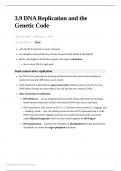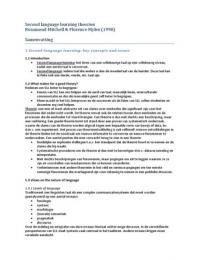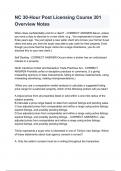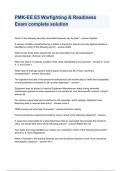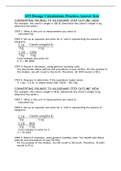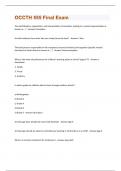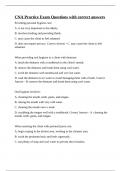Approach 3rd Edition
Summary
Chapter 1 - Thinking like a scientist
Module 1 - Science and Psychology
Areas of psychological research
The American Psychological Association (APA) has 54 divisions, each representing an area
of research and practice. One of the most popular research areas is psychobiology, which
combines biology and psychology. Psychobiologists typically study brain organization or the
chemicals in the brain (neurotransmitters).
Cognitive scientists study the mind: they are interested in how humans process, store and
retrieve information and solve problems.
Human Development psychologists conduct research on human physical, social and
cognitive development.
Social psychologists are interested in how we view and affect one another, combining the
disciplines of psychology and sociology.
Psychotherapy is designed to assess whether a therapy is really effective in helping
individuals.
Sources of knowledge
● Knowledge via superstition: acquiring knowledge based on subjective feelings, belief
in chance, or belief in magical events and is not based on observation or hypothesis
testing.
● Knowledge via intuition: knowledge gained without being consciously aware of its
source. Events may be misinterpreted and not representative of all events in that
category.
● Knowledge via authority: knowledge gained from those viewed as authority figures,
such as parents and teachers. Problems may arise when the perceived authority
figure really is not knowledgeable in the subject area.
● Knowledge via tenacity: knowledge gained from repeated ideas and stubbornly clung
to despite evidence suggesting otherwise. Mostly used by politicians and advertisers.
● Knowledge via rationalism: knowledge gained through logical reasoning. Rational
ideas are often presented in the form of a syllogism. However, if the content of either
premise in the syllogism is false, then the conclusion is logically valid but empirically
false.
● Knowledge via empiricism: knowledge gained through objective observations of
organisms and events in the real world. However, it only leads to a list of
observations and facts, thus we need to use rationalism with empiricism to make
sure that the observations are logical.
, ● Knowledge via science: knowledge gained through a combination of empirical
methods and logical reasoning. Scientists collect data (empirical) and test
hypotheses with these data (rationalism). A hypothesis is a prediction regarding the
outcome of a study, which often concerns the relationship between two variables (a
variable is an event or behavior that has at least two values). By merging rationalism
and empiricism, we have the advantage of using a logical argument based on
observation. The goal of testing hypotheses is to arrive at or to test a theory, which is
an organized system of assumptions and principles that attempts to explain
phenomena and how they are related. A theory may aid in the development of future
hypotheses.
The scientific (critical thinking) approach and psychology
What defines science is how something is studied. The scientific method requires developing
an attitude of skepticism. A skeptic is a person who questions the validity, authenticity, or
truth of something purportedly factual. They do not blindly accept a new idea.
Using the scientific method involve applying three important criteria that help define science:
systematic empiricism, public verification, and empirically solvable problems
● Systematic empiricism: making observations in a systematic manner in order to test
hypotheses and develop or refute a theory.
● Public verification: presenting research to the public so it can be observed,
replicated, criticized, and tested. Most journals are peer reviewed; other scientists
critique the research in order to decide whether it meets the standards for
publication.
● Empirically solvable problems: questions that are potentially answerable by means of
currently available research techniques. When solvable problems are studied, they
are always open to the principle of falsifiability, meaning that a scientific theory
must be stated in such a way that it is possible to refute or disconfirm it. The theory
must predict not only what will happen but also what will not happen. A theory is not
scientific if it is irrefutable.
- Pseudoscience: a claim that appears to be scientific but that actually violates
the criteria of science. It is usually irrefutable and confused with science.
Basic and applied research
The first type of research is basic research, which is the study of psychological issues in
order to seek knowledge for its own sake. The intent is to gain knowledge. It is usually
conducted in university or laboratory settings.
The second type of research is applied research, which involves the study of psychological
issues that have significance and potential solutions. Scientists who conduct applied
research are interested in finding an answer to a question because the answer can be
immediately applied. It is usually conducted by private businesses and the government.
,Goals of science
● Description: carefully observing behavior in order to describe it. Description allows
us to learn about behavior as well as when it occurs. It also allows us to observe
when two events are systematically related to one another. Without description as a
first step, predictions cannot be made.
● Prediction: identifying the factors that indicate when an event or events will occur.
Knowing the level of one variable allows us to predict the approximate level of the
other variable.
● Explanation: identifying the causes that determine when and why a behavior occurs.
To explain a behavior, we need to demonstrate that we can manipulate the factors
needed to produce or eliminate it. When trying to identify the best explanation, we
must systematically eliminate any alternative explanations.
Module 2 - An Introduction to Research Methods
Descriptive methods
Psychologists use three types of descriptive methods:
● Observational method: making observations of human or other animal behavior. It
involves description at its most basic level. The advantage is that this method is
flexible, however the disadvantage is that it offers little control. Psychologists
approach observation in two ways:
- Naturalistic observation: observing the behavior of humans or other animals
in their natural habitats.
- Laboratory observation: observing the behavior of humans or other animals in
a contrived and controlled situation.
● Case study method: an in-depth study of one or more individuals. This method is
descriptive in nature because it involves simply describing the individual(s) being
studied.
● Survey method: questioning individuals on a topic or topics and then describing their
responses. One advantage of the survey method is that it allows researchers to study
larger groups of individuals more easily than the other methods. However, it has
disadvantages. One concern is whether the group of people who participate in the
study (the sample) is representative of all the people about whom the study is meant
to generalize (the population). This concern can usually be overcome through
random sampling. A random sample is achieved when through random selection
each member of the population is equally likely to be chosen as part of the sample.
Predictive (relational) methods
There are two methods that allow researchers to describe behaviors and to predict from one
variable to another.
The first method is the correlational method, which assesses the degree of relationship
between two measured variables. If two variables are correlated with each other, then we
, can predict from one variable to the other with a certain degree of accuracy, for example
weight and height. A problem with this method is that it is often misinterpreted. People
assume that because two variables are correlated, there is a relation between the two, which
is not the case. Correlation does not imply causation. The two variables are only related, but
do not cause another. Correlation can have a positive or a negative relationship. In a
positive relationship, if variable 1 increases or decreases, variable 2 increases or decreases
as well, and vice versa. In a negative relationship, if variable 1 increases or decreases,
variable 2 does the opposite, and vice versa. It allows us to predict the variable based on the
other.
The second method is the quasi-experimental method, which allows us to describe and
predict by permitting us to compare naturally occurring groups of individuals. The variable of
interest can not be manipulated. This type of variable is often referred to as a subject or
participant variable.
What is missing when using predictive methods such as the correlational and
quasi-experimental methods is control, because we cannot determine the causation. There
could be an alternative explanation for a relation between two variables. It is possible that
another variable may be responsible for the relation.
Explanatory method
When using the experimental method, researchers pay a great deal of attention to
eliminating the possibility of alternative explanations by using the proper controls. This
allows researchers to describe and predict, and also to determine whether there is a
cause-and-effect relationship between the variables of interest. The researcher controls as
much as possible to determine whether there is a cause-and-effect relationship between
variables.
The variable that is being manipulated with this method is called the independent variable
and the variable that is being measured is called the dependent variable. The independent
variable has to have at least 2 groups/conditions, called the control group, which serves as
the standard condition, and the experimental group, which receives the controlled
treatment in an experiment/study.
Researchers need to control the type of subjects in each of the treatment conditions. They
begin by drawing a random sample of subjects from the population. Then, they have to
decide who serves in the control group and who in the experimental group. To gain as much
control as possible and to eliminate as many alternative explanations as possible, they use
random assignment: assigning subjects to conditions in such a way that each has the
same probability as any other subject of being placed in any condition and minimizes
differences between the groups. The only difference researchers want between the groups is
that of the independent variable we are manipulating.
Doing science
Most researchers do not wholeheartedly accept a conclusion based on only one study.
There may have been control problems, such as an uncontrolled factor affecting the results.
A study may also be limited by the technical equipment available at the time. Finally, we
cannot completely rely on the findings of one study because a single study cannot tell us
everything about a theory. The theories generated through science change evolve over time.




